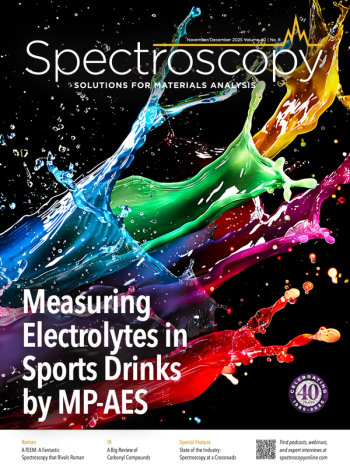
Earth Day 2025: The Latest in Environmental Analysis
Here is a collection of recent studies that used spectroscopic techniques in environmental analysis.
Happy Earth Day from Spectroscopy!
In celebration of Earth Day, we are happy to present you with a curated collection of recent studies that explored the role spectroscopy has played in environmental analysis. Here, you will see how techniques such as Raman spectroscopy, Fourier transform infrared (FT-IR) spectroscopy, and fluorescence spectroscopy have been used in environmental analysis. Happy reading!
In a recent study led by Ainara Pocheville at Spain’s Gaiker Technology Centre, Pocheville and others explored a new way to identify plastics in waste electrical and electronic equipment (WEEE) recycling. Using Raman spectroscopy and two machine learning (ML) algorithms, discriminant analysis (DA) and support vector machine (SVM), the team achieved up to 80% classification purity for key plastics like polystyrene (PS) and acrylonitrile butadiene styrene (ABS) (1). By optimizing laser settings and analyzing real-world WEEE samples, the researchers demonstrated a scalable, AI-enhanced method for sorting complex plastic mixtures (1). This approach could boost recovery rates, reduce reliance on virgin materials, and support global efforts toward plastics circularity and environmental sustainability.
A recent study led by Bibhudutta Rout of the University of North Texas highlights the potential of micro-particle-induced X-ray emission (micro-PIXE) spectroscopy for identifying pollution sources in urban and indoor air. The research conducted analyzed particulate matter from Old Delhi’s markets and Panjab University hostels, revealing different elemental compositions tied to pollution sources like coal plants, traffic, and biomass burning (2). Using high-resolution elemental mapping and GeoPIXE software, the team showcased a non-destructive, sensitive method for environmental forensics (2). The findings support micro-PIXE’s value in monitoring air quality, particularly in high-pollution areas like Delhi, India.
Researchers from the National University of Mongolia recently investigated solvent-based extraction of bituminous and sub-bituminous coals using traditional and ionic liquid (IL) solvents (3). This study, which was published in the Journal of Spectroscopy, aimed to develop cleaner coal use for Mongolia’s cold climate. Using FT-IR spectroscopy and scanning electron microscope with energy dispersive X-ray spectrometry (SEM-EDS), the research team analyzed functional group changes and mineral content in Tavantolgoi and Alagtogoo coal samples. Ionic liquid (IL)-based extraction, particularly with [Bmim]Cl⁻, showed promising solubility, effective mineral removal, and enhanced hydrogen bonding in bituminous coal (3). Findings suggest ILs may offer an environmentally friendly alternative to traditional solvents for coal processing, with potential applications in sustainable energy strategies (3).
A recent study in Chemical Engineering Journal, led by Ying Zhang and Yifan Wang from Northeast Agricultural University, explored how aging affects biochar’s role in controlling dissolved organic matter (DOM) and cadmium in soil (4). Using corn straw biochar, the team applied three aging treatments and found that ultraviolet (UV) aging released the most DOM. However, freeze-thaw and untreated biochar better reduced cadmium bioavailability because of higher humic acid content (4). Techniques like excitation-emission matrix (EEM) fluorescence spectroscopy and parallel factor analysis (PARAFAC) showed that aging impacts DOM structure and biochar effectiveness (4). The findings offer valuable insights for optimizing biochar in sustainable soil remediation and pollution control.
A recent study from Zhengzhou Police University, published in the Journal of Raman Spectroscopy, demonstrated how combining Raman spectroscopy with convolutional neural networks (CNNs) can enhance forensic plastic identification. Researchers analyzed 40 plastic beverage bottles, focusing on polyethylene terephthalate (PET) and polyethylene (PE). Using preprocessing techniques like Savitzky–Golay smoothing and multiple scattering correction, they improved spectral clarity for CNN analysis (5). The CNN achieved 100% classification accuracy, significantly outperforming traditional methods (5). This non-destructive, artificial intelligence (AI)-enhanced approach promises faster, more accurate forensic analysis and may also aid in environmental monitoring, offering a powerful tool for material identification.
References
- Wetzel, W. New Raman Spectroscopy Breakthrough Boosts E-Waste Plastic Recycling Efficiency. Spectroscopy. Available at:
https://www.spectroscopyonline.com/view/new-raman-spectroscopy-breakthrough-boosts-e-waste-plastic-recycling-efficiency (accessed 2025-04-21). - Wetzel, W. New Study Uses Micro-PIXE Spectroscopy to Trace Pollution Sources in Indian Air Samples. Spectroscopy. Available at:
https://www.spectroscopyonline.com/view/new-study-uses-micro-pixe-spectroscopy-to-trace-pollution-sources-in-indian-air-samples (accessed 2025-04-21) - Acevedo, A. Analyzing Coals Using Fourier Transform Infrared Spectroscopy. Spectroscopy. Available at:
https://www.spectroscopyonline.com/view/analyzing-coals-using-fourier-transform-infrared-spectroscopy (accessed 2025-04-21). - Wetzel, W. Can Fluorescence Spectroscopy Evaluate Soil Dissolved Organic Matter Dynamics? Spectroscopy. Available at:
https://www.spectroscopyonline.com/view/can-fluorescence-spectroscopy-evaluate-soil-dissolved-organic-matter-dynamics- (accessed 2025-04-21). - Wetzel, W. AI-Powered Raman Spectroscopy Boosts Crime Investigations with Plastic Bottle Identification. Spectroscopy. Available at:
https://www.spectroscopyonline.com/view/ai-powered-raman-spectroscopy-boosts-crime-investigations-with-plastic-bottle-identification (accessed 2025-04-21).
Newsletter
Get essential updates on the latest spectroscopy technologies, regulatory standards, and best practices—subscribe today to Spectroscopy.


